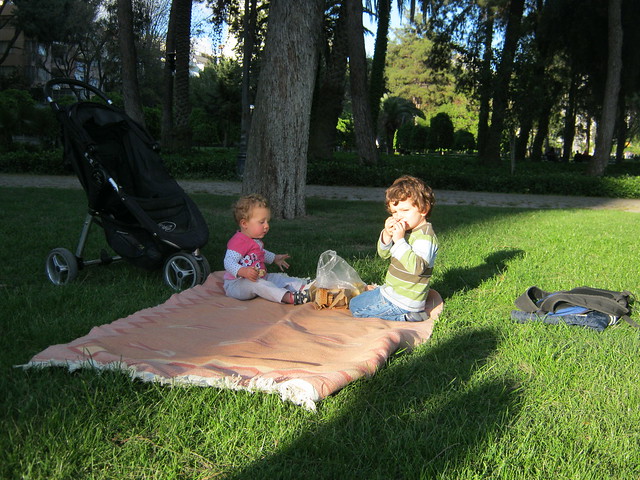Photo by Jake Olson, January 1, 1980,
Picnic at Ataturk Park
Why go on picnics? Why go to the work of taking perfectly good food, boxing it up, going somewhere that’s not home, and then pulling it out and eating it? The ants want some, the wind keeps blowing the napkins around, and the mosquitoes think that they are honored guests. A picnic is an event during with which someone prepares or buys three times as much as needed for a meal, packages it to avoid spoilage and marauders, and goes to the work of taking it some place else.
Picnics, defined as special meals out of doors, have a long history, from the ancient Greece symposia to medieval hunting feasts to aristocrats’ eighteenth century picnics with china, silver, tables and linen clothes in romantically pastoral settings. In Egypt, people celebrate the arrival of spring with picnics, a tradition echoed in the Japanese cherry blossom viewing feasts. Their descendants, tailgate picnics before football games are culturally far removed, but serve the same needs – camaraderie, celebration, and the alchemy by which ordinary baked beans are turned to exotic food by being transported to a different location.
Fading pictures in photo albums testify to the fact that both of my grandmothers were fond of having their husbands and kids set up long tables and folding chairs in the backyard. They laid out tablecloths, and set out potato salads, fried chicken, deviled eggs, sliced ham, egg salad, Jell-O salads, three-bean salads, white-bread dinner rolls, and relish plates. When everyone had feasted to their hearts’ content, the dishes were cleared away, and the homemade pies and cakes came out. All the relatives, and mostly only relatives came, and dozens of adults and kids shared the yard with croquet wickets off to the side.
My mother’s more modest picnics gave her a reason to get the seven kids out of the house on the long summer days, and ran more to peanut butter and jelly sandwiches and celery and carrot sticks. Someone carried the jug of Kool-Aid, and someone hauled the picnic blanket and off we went to the frog pond or just the back yard. The kids loved it just as much as Mother did. It was all finger food, so manners weren’t mentioned and cleanup was minimal. The ants got the crumbs and you could watch them carry them away down their sandy ant holes.
Whether bread and cheese on a bench in an ancient European square, or sandwiches consumed while looking out on the Pacific like Cortez in Keats’s sonnet, or s’ mores capping off an evening bonfire with kids chasing fireflies, picnics appeal to the Dionysian. They enhance both food and place, together making a space of timelessness out of those two ingredients. Jean Anthelme Brillat-Savarin says, “ . . . Seated on the green turf they eat, the corks fly; they gossip, laugh, and are merry in perfect freedom, for the universe is their drawing-room, and the sun their lamp" (Physiologie du goût, pp. 152–153) [http://www.answers.com/topic/picnic].
